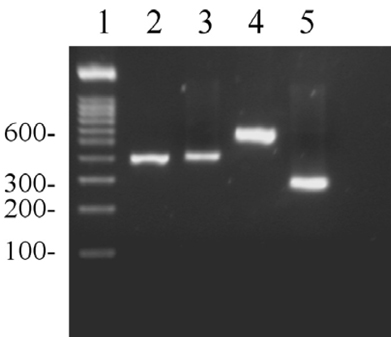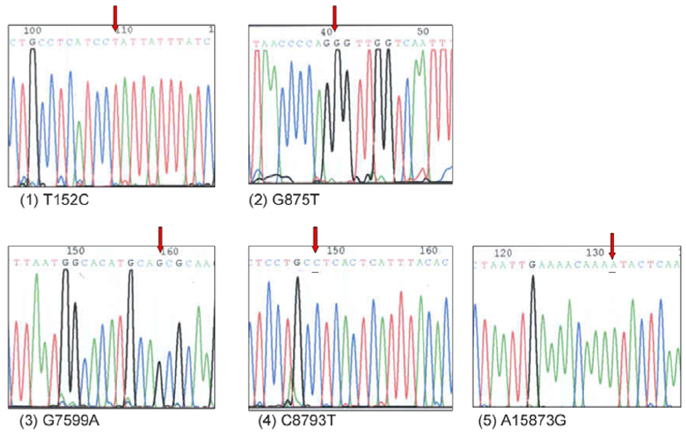J Clin Neurol.
2007 Sep;3(3):127-132. 10.3988/jcn.2007.3.3.127.
Screening of the A11084G Polymorphism and Scanning of a Mitochondrial Genome SNP in Korean Migraineurs
- Affiliations
-
- 1Department of Neurology, Seoul National University Hospital, Seoul, Korea. kimmanho@snu.ac.kr
- 2Program in Public Health Service, Seoul National Mental Hospital, Seoul, Korea.
- 3Department of Neurology, College of Medicine, Kangwon National University, Seoul, Korea.
- 4Seoul Science High School, Korea.
- 5Department of Neurology, Eulji University Hospital and School of Medicine, Eulji University, Seoul, Korea.
- KMID: 2135490
- DOI: http://doi.org/10.3988/jcn.2007.3.3.127
Abstract
- BACKGROUND AND PURPOSE
Migraine is a genetically heterogeneous disorder that is frequently associated with a familial history, and mitochondrial dysfunction has been suggested to be associated with its pathogenesis. We screened and scanned mitochondrial gene polymorphisms to determine the significance of mitochondrial DNA mutations in Korean migraineurs.
METHODS
One hundred and sixty-four migraineurs aged 33.9+/-11.7 years (mean+/-SD range 12 to 65 years) were studied. Clinical data of the familial history were obtained, and blood samples were collected for DNA purification. An A-to-G substitution at mitochondrial DNA (mtDNA) position 11,084 (A11084G) was determined by a polymerase chain reaction (PCR) with BsmI restriction. In addition, new single-nucleotide polymorphism (SNP) sites in the mitochondrial genome were scanned for using PCR and direct sequencing.
RESULTS
Ninety-eight migraine patients (59.8%) had a maternal familial history. The A11084G polymorphism, which was previously reported in 25% of Japanese migraineurs, was not evident in our Korean migraine patients. However, scanning of new SNP sites in mtDNA revealed six candidate SNPs whose incidences were higher in migraine patients than in normal subjects.
CONCLUSIONS
Our study found no association between the A11084G polymorphism in mitochondrial DNA and migraine in Koreans. However, we found potential new mitochondrial SNP sites in Korean migraineurs, which warrant further investigation.
MeSH Terms
Figure
Cited by 1 articles
-
Frovatriptan is Effective and Well Tolerated in Korean Migraineurs: A Double-Blind, Randomized, Placebo-Controlled Trial
Heui-Soo Moon, Min Kyung Chu, Jeong Wook Park, Kyungmi Oh, Jae Myun Chung, Yong Jin Cho, Eung Gyu Kim, Jin Kuk Do, Hyong Gi Jung, Sun Uck Kwon
J Clin Neurol. 2010;6(1):27-32. doi: 10.3988/jcn.2010.6.1.27.
Reference
-
1. Lee JY, Kim M. Current issues in migraine genetics. J Clin Neurol. 2005. 1:8–13.
Article2. Welch KM, Ramadan NM. Mitochondria, magnesium and migraine. J Neurol Sci. 1995. 134:9–14.
Article3. Klopstock T, May A, Seibel P, Papagiannuli E, Diener HC, Reichmann H. Mitochondrial DNA in migraine with aura. Neurology. 1996. 46:1735–1738.
Article4. Sparaco M, Feleppa M, Lipton RB, Rapoport AM, Bigal ME. Mitochondrial dysfunction and migraine: evidence and hypotheses. Cephalalgia. 2006. 26:361–372.5. Haan J, Terwindt GM, Maassen JA, Hart LM, Frants RR, Ferrari MD. Search for mitochondrial DNA mutations in migraine subgroups. Cephalalgia. 1999. 19:20–22.
Article6. Shimomura T KA, Marukawa H, Takahashi K. Mutation in platelet mitochondrial gene in patients with migraine. Cephalalgia. 1995. 15:10.7. Russell MB, Diamant M, Norby S. Genetic heterogeneity of migraine with and without aura in Danes cannot be explained by mutation in mtDNA nucleotide pair 11084. Acta Neurol Scand. 1997. 96:171–173.
Article8. Matsumoto H, Miyazaki T, Suzuki K. Characteristics of japanese, Korean, and Chinese populations based on the genetic markers of human immunoglobulins. Z Morphol Anthropol. 1995. 81:23–32.
Article9. Min PG. A comparison of the Korean minorities in China and Japan. Int Migr Rev. 1992. 26:4–21.
Article10. Headache Classification Subcommittee of the International Headache Society. The International Classification of Headache Disorders, 2nd edition. Cephalalgia. 2004. 24:Suppl 1. 9–160.11. Ingman M, Kaessmann H, Pääbo S, Gyllensten U. Mitochondrial genome variation and the origin of modern humans. Nature. 2000. 408:708–713.
Article12. Mishmar D, Ruiz-Pesini E, Golik P, Macaulay V, Clark A, Hosseini S, et al. Natural selection shaped regional mtDNA variation in humans. Proc Natl Acad Sci USA. 2003. 100:171–176.
Article13. Sakuta R, Goto Y, Nonaka I, Horai S. An A-to-G transition at nucleotide pair 11084 in the ND4 gene may be an mtDNA polymorphism. Am J Hum Genet. 1993. 53:964–965.14. Takeshima T, Fukuhara Y, Adachi Y, Ishizaki K, Kusumi M, Kowa H, et al. Leukocyte mitochondrial DNA A to G polymorphism at 11084 is not a risk factor for Japanese migraineurs. Cephalalgia. 2001. 21:987–989.
Article15. Lehmann-Horn F. Disease-causing mutations or functional polymorphisms? Acta Myol. 2004. 23:85–89.16. Russell MB, Olesen J. Increased familial risk and evidence of genetic factor in migraine. BMJ. 1995. 311:541–544.
Article17. Ziegler DK, Hur YM, Bouchard TJ Jr, Hassanein RS, Barter R. Migraine in twins raised together and apart. Headache. 1998. 38:417–422.
Article18. Joutel A, Bousser MG, Biousse V, Labauge P, Chabriat H, Nibbio A, et al. A gene for familial hemiplegic migraine maps to chromosome 19. Nat Genet. 1993. 5:40–45.
Article19. Ophoff RA, Terwindt GM, Vergouwe MN, van Eijk R, Oefner PJ, Hoffman SM, et al. Familial hemiplegic migraine and episodic ataxia type-2 are caused by mutations in the Ca2+ channel gene CACNL1A4. Cell. 1996. 87:543–552.
Article20. Tournier-Lasserve E. Sandler M, Ferrari M, Harnett S, editors. Genetics of familial hemiplegic migraine. Migraine: Pharmacology and Genetics. 1996. 1st edn. London: Chapman & Hall;282–290.21. Dichgans M, Forderreuther S, Deiterich M, Pfaffenrath V, Gasser T. The D2 receptor NcoI allele: absence of allelic association with migraine with aura. Neurology. 1998. 51:928.22. Peroutka SJ, Wilhoit T, Jones K. Clinical susceptibility to migraine with aura is modified by dopamine D2 receptor (DRD2) NcoI alleles. Neurology. 1997. 49:201–206.
Article23. Peroutka SJ, Price SC, Wilhoit TL, Jones KW. Comorbid migraine with aura, anxiety, and depression is associated with dopamine D2 receptor (DRD2) NcoI alleles. Mol Med. 1998. 4:14–21.
Article24. Goadsby PJ. Recent advances in understanding migraine mechanisms, molecules and therapeutics. Trends Mol Med. 2007. 13:39–44.
Article25. Montagna P. Magnetic resonance spectroscopy in migraine. Cephalalgia. 1995. 15:323–327.
Article
- Full Text Links
- Actions
-
Cited
- CITED
-
- Close
- Share
- Similar articles
-
- MitGEN: Single Nucleotide Polymorphism DB Browser for Human Mitochondrial Genome
- Understanding of single nucleotide polymorphism of human genome
- Comparison of the Affymetrix SNP Array 5.0 and Oligoarray Platforms for Defining CNV
- Analysis of Nuclear Mitochondrial DNA Segments of Nine Plant Species: Size, Distribution, and Insertion Loci
- Application of Single Nucleotide Polymorphism in Forensic Science



